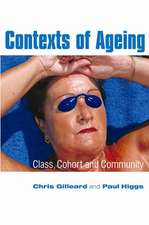Old Age in Nineteenth-Century Ireland: Ageing under the Union
Autor Chris Gillearden Limba Engleză Hardback – 29 mai 2017
Preț: 408.91 lei
Nou
Puncte Express: 613
Preț estimativ în valută:
78.26€ • 81.29$ • 65.00£
78.26€ • 81.29$ • 65.00£
Carte tipărită la comandă
Livrare economică 03-17 februarie 25
Preluare comenzi: 021 569.72.76
Specificații
ISBN-13: 9781137585400
ISBN-10: 1137585404
Pagini: 114
Ilustrații: XXVI, 114 p. 3 illus.
Dimensiuni: 148 x 210 x 16 mm
Greutate: 0.32 kg
Ediția:1st ed. 2017
Editura: Palgrave Macmillan UK
Colecția Palgrave Pivot
Locul publicării:London, United Kingdom
ISBN-10: 1137585404
Pagini: 114
Ilustrații: XXVI, 114 p. 3 illus.
Dimensiuni: 148 x 210 x 16 mm
Greutate: 0.32 kg
Ediția:1st ed. 2017
Editura: Palgrave Macmillan UK
Colecția Palgrave Pivot
Locul publicării:London, United Kingdom
Cuprins
List of figures and tables-. Acknowledgements-. Preface-. Chapter 1 Ireland at the time of the Union-. Chapter 2 Ireland’s changing demography-. Chapter 3 Change in family and household structure-. Chapter 4 Poverty and old age-. Chapter 5 Growing older, growing sicker?-. Chapter 6 Conclusions-. Appendices-. Bibliography-.
Notă biografică
Chris Gilleard is a visiting research fellow in the Division of Psychiatry at University College London, UK, and senior visiting research fellow at the University of Bath, UK. Author and co-author with Paul Higgs of a number of books addressing ageing and old age -including Cultures of Ageing (2000); Ageing, Corporeality and Embodiment (2013) and Rethinking Old Age (2015)- his interests in later life span a wide range of disciplines from bio medicine to the humanities.
Textul de pe ultima copertă
Using a combination of statistical analysis of census material and social history, this book describes the ageing of Ireland’s population from the start of the Union up to the introduction of the old age pension in 1908. It examines the changing demography of the country following the Famine and the impact this had on household and family structure. It explores the growing problem of late life poverty and the residualisation of the aged sick and poor in the workhouse. Despite slow improvements in many areas of life for the young and the working classes, the book argues that for the aged the union was a period of growing immiseration, brought surprisingly to an end by the unheralded introduction of the old age pension.
Caracteristici
Draws upon a combination of censal material, royal inquiries and poor law commissioner reports to trace the position of the aged in Ireland across the nineteenth century. Examines the impact that a changing demography in Ireland, following the Famine,had on household and family structure. Assesses the impact of the introduction of the old age pension in 1908 on an ageing population in Ireland.

























